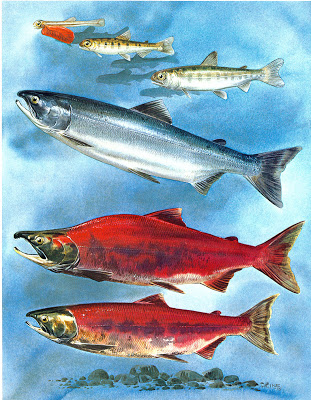Sockeye Salmon
Oncorhynchus nerka
Sockeye salmon are also known as red salmon.
Description: Sockeye are commonly known as “red” salmon, especially in Alaska due to the bright reddening (especially in males) of the body when adults return to spawn in freshwater. During this transformation, the head becomes greenish with the hooking of the jaws especially in males and a small dorsal hump in males (much less pronounced than in male pink salmon). Before developing their spawning colors, ocean sockeye have a greenish-blue hue (blueback salmon) with fine black speckles on their backs. They can reach up to a length of 33 inches and weigh up to 15 pounds, although on average they typically weigh between 5 and 8 pounds.
In Whatcom County: Because there is no suitable lake associated with the Nooksack River, there are no “lacustrine sockeye” in the watershed (see below for Life History). There are small numbers of riverine sockeye in two Nooksack River populations; one in the North/Middle Fork and one in the South Fork. However, lacustrine sockeye are present in the county’s Baker Lake. Adults are trapped from the Baker River (Skagit River tributary) at Concrete and transported for release into Baker Lake above the upper of the two Pound Sound Energy hydroelectric dams or used in hatchery production or held in spawning channels for release of juveniles into the lake for rearing for a year. Smolts are collected from the lake and transported for release into the free flowing Baker River.
Range: Columbia River northward to the Bering Sea’s Bristol Bay (greatest abundance is from Bristol Bay south to the Fraser River) and along the east coast of Asia with most abundance in the Sea of Okhotsk and the Kamchatka Peninsula.
Life History: Nearly all sockeye populations are “lacustrine” meaning the life cycle is dependent upon a period of juvenile rearing in a lake. Riverine populations spawn in a river and the juveniles rear in the river before migrating to the ocean. Lacustrine sockeye spawn in a lake’s tributary streams or its outflow stream or along the lake’s shore. Juveniles rear for one to two years in the lake before the smolts migrate to the ocean. The lacustrine type life cycle requires precise homing to the watershed with one or more lakes. Riverine sockeye juveniles tend to migrate to the ocean after a few months in freshwater.
Spawning Season: August to October.
Habitat Requirements: For lacustrine sockeye, those spawning in a stream have the same requirements as other salmon of cool, clean, well oxygenated water and clean gravel of appropriated size and depth. Those spawning along a lake shore require ground water upwelling through the gravel for the incubating eggs and alevins (sac fry). Once in the lake, the juveniles require sufficient production of zooplankton for growth. Riverine sockeye have the same requirements as other stream spawning salmon.
Did You Know: The kokanee of Lake Whatcom, Lake Padden and Lake Samish are non-anadromous sockeye and were originally derived from sockeye. They complete their life cycle while in freshwater. Sockeye are mainly filter feeders and their red flesh and body color when spawning is from carotenoids (think of carrots) consumed in their ocean rich diet of krill (the zooplankton of mostly small crustaceans, other small invertebrates and larval fishes). The name sockeye is from a translation of the Salish language “Suk-kegh” meaning red fish. Sockeye is the third most abundant species of Pacific salmon. One of the largest runs of sockeye occurs every four years when fish entering the Fraser River migrate to the Adams River in British Columbia. East of Kamloops and near Shuswap Lake, the Roderick Haig-Brown Provincial Park on the Adams River provides a great viewing opportunity. The next predominant run years are 2018 and 2022.
Photo credit: Pacific Salmon- Childerhose and Trim - Douglas & McIntyre Vancouver/Toronto

